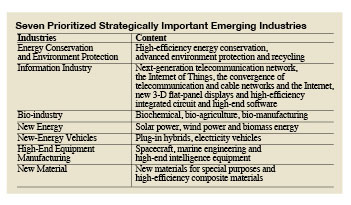|

But problems surfaced as local governments tried to introduce their own incentives without a central plan to regulate the nationwide development of emerging industries, Li said.
The recent decision, in this sense, will serve as a blueprint for the development of emerging industries, he said.
A great stride
The decision to develop emerging industries marks a high point in China's industrialization, said Chen Qingtai, Deputy Director of the Subcommittee for Economic Affairs of the National Committee of the Chinese People's Political Consultative Conference.
Chen said that due to a lack of technology, capital and market access, the Chinese economy's boom has been largely reliant on cheap labor, abundant resources and large environmental capacities. The country has seen rapid expansion in its economic scale and remarkable growth in its exports, particularly since its entrance into the WTO, making it one of the biggest winners of globalization, he said.
But, the resource-reliant economic growth model is unsustainable, and the current costs of labor and other production factors are not as low as they used to be. As a result, the Central Government proposed a fundamental change in the growth pattern, requesting more efficiency in the 1990s. The proposal yielded few results, though, as local governments were reluctant to implement the changes. The old growth pattern, however, no longer matches China's shifting manufacturing landscape.
China is ready for a new takeoff, backed by a knowledgeable, still-growing talent pool, improved corporate management, a sophisticated team of entrepreneurs, enhanced technological innovation capacity and higher success rates for innovation, Chen said.
A large gap exists between developing countries and developed countries in terms of sophisticated technologies, but the gap is not that big for new technologies, he said.
There are opportunities for developing countries to take the lead in the development of emerging industries. The technologies are so new that barriers such as intellectual property rights are not yet formed, and uncertainty remains over industry dominance and business models, Chen noted.
China will take advantage of this opportunity to achieve technological progress and industrial upgrades, and usher in a new round of industrialization, he said.
During this process, promising investment opportunities and new jobs will be created and form a sort of new growth momentum. This momentum will promote major transformations in the Chinese economy, which will shift from a technology consumer to a technology innovator, and from a model of resource-reliant growth to one of innovation-driven economic growth, he said.
These desired changes will greatly help alleviate environmental pressures and keep the country on a path of sustainable growth, he concluded.
Perseverance
While cultivating and developing emerging industries, the country needs capital-intensive investments, breakthroughs in key technological bottlenecks, supportive policies to promote the industrialization of major research achievements and better market access, said Zhu Min, a researcher with the State Information Center.
Capital is the first problem. Technologies in emerging industries are not mature, and the market must wait and see which technologies and products will prevail over others. During this period, researchers conduct numerous time- and capital-consuming experiments, which may demand hefty, systematic fiscal and financial supports, he said.
But at present, China is lagging behind many developed countries, both in terms of the amount of investments and the incentive system. China's R&D expenses accounted for just 1.62 percent of the GDP last year, while the rate of developed countries is usually 2.5-2.8 percent, he said.
Many businesses in the seven strategically important emerging industries lack control of core technologies, as well as a competitive technology system on par with developed countries. Reliant on imports of core technologies and equipment, companies in these industries have little cost competitiveness, and this restricts them from further tapping into new markets at home and abroad, Zhu added said.
The wind power industry, for example, is weak in large wind turbine design and key component manufacturing, despite its remarkable installed capacity. China now is the world's largest producer of solar panels, but it does not control core technologies, such as high-efficiency thin-film solar cells. For the information industry, China has made progress in research and the development of equipment and systems, but must still attain breakthroughs in fundamental technologies related to chips, photo-electricity and high-efficiency computers, he said.
"The development of strategically important emerging industries demands a long period of market cultivation," he added. | 